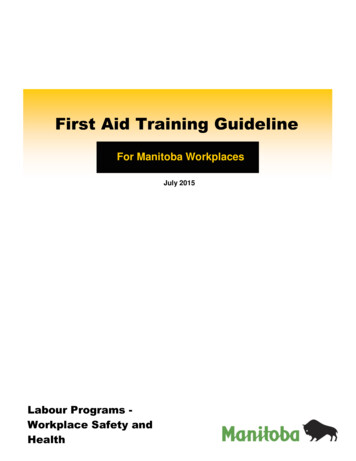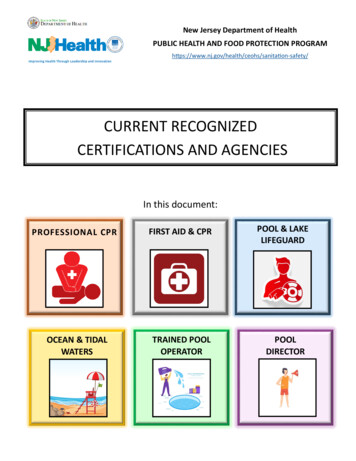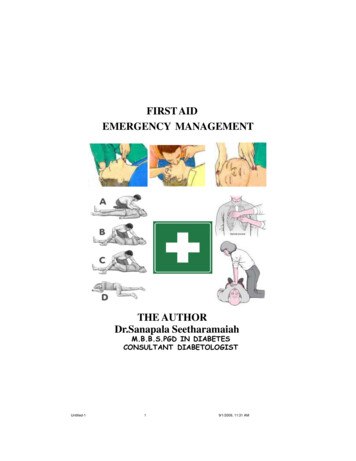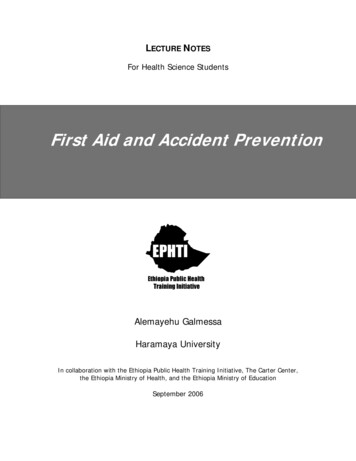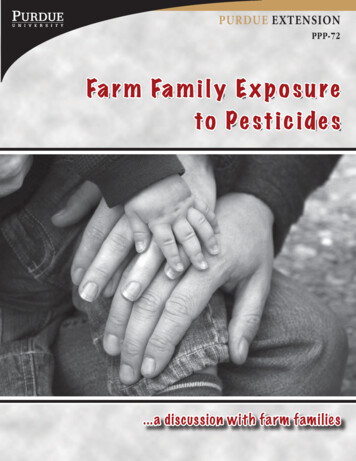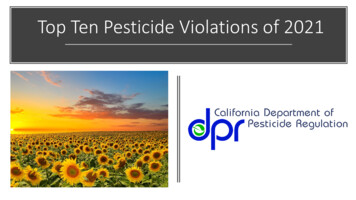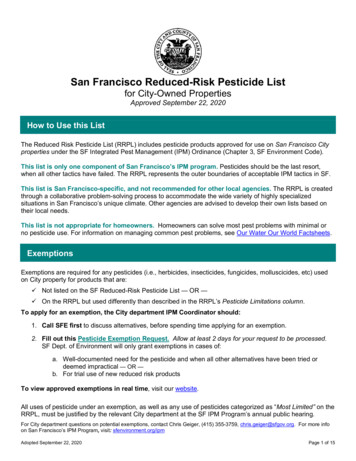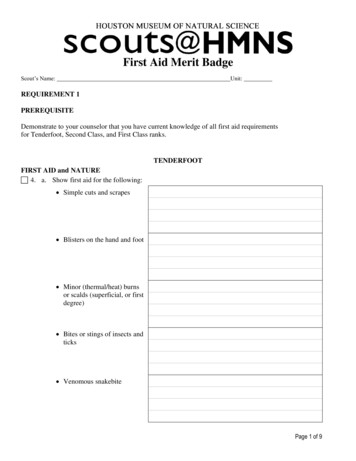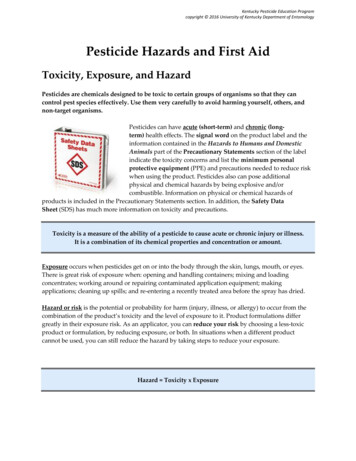
Transcription
Kentucky Pesticide Education Programcopyright 2016 University of Kentucky Department of EntomologyPesticide Hazards and First AidToxicity, Exposure, and HazardPesticides are chemicals designed to be toxic to certain groups of organisms so that they cancontrol pest species effectively. Use them very carefully to avoid harming yourself, others, andnon-target organisms.Pesticides can have acute (short-term) and chronic (longterm) health effects. The signal word on the product label and theinformation contained in the Hazards to Humans and DomesticAnimals part of the Precautionary Statements section of the labelindicate the toxicity concerns and list the minimum personalprotective equipment (PPE) and precautions needed to reduce riskwhen using the product. Pesticides also can pose additionalphysical and chemical hazards by being explosive and/orcombustible. Information on physical or chemical hazards ofproducts is included in the Precautionary Statements section. In addition, the Safety DataSheet (SDS) has much more information on toxicity and precautions.Toxicity is a measure of the ability of a pesticide to cause acute or chronic injury or illness.It is a combination of its chemical properties and concentration or amount.Exposure occurs when pesticides get on or into the body through the skin, lungs, mouth, or eyes.There is great risk of exposure when: opening and handling containers; mixing and loadingconcentrates; working around or repairing contaminated application equipment; makingapplications; cleaning up spills; and re-entering a recently treated area before the spray has dried.Hazard or risk is the potential or probability for harm (injury, illness, or allergy) to occur from thecombination of the product’s toxicity and the level of exposure to it. Product formulations differgreatly in their exposure risk. As an applicator, you can reduce your risk by choosing a less-toxicproduct or formulation, by reducing exposure, or both. In situations when a different productcannot be used, you can still reduce the hazard by taking steps to reduce your exposure.Hazard Toxicity x Exposure
The greatest exposure hazard usually occurswhile mixing and loading concentrated pesticides.Hazards associated with the actual application arefrequently much lower when diluted pesticides arehandled or applied. The hazards may still besubstantial, however, in the case of a single highexposure (such as when an accident occurs) or whenmany smaller exposures occur over an extended period.The best way to reduce or avoid the risks of pesticides isto understand the products that you are using and know how to handle and apply them safely. Readthe label carefully and follow its instructions. Your attitude is most important. If you assume thatyou know exactly how to use a pesticide without reading the product label or do not bother to takethe precautions indicated on the label, then you are more likely to experience excess exposure.When handling pesticides, you have a legal and moral obligation to protect both your health andthat of others. Besides protecting yourself, you must be aware of other people, wildlife, or pets thatmay be in or near the treatment area. They could be exposed to the pesticide during or afterapplication. By following good safety practices you reduce the chance of exposure.The pesticide registration process requires manufacturers to do risk assessment studies. They thendevelop product labels that provide instructions on minimizing exposure. The labels specifypersonal protective equipment (PPE), engineering controls, symptoms of overexposure, first aid, andpost-application restricted-entry intervals (REIs).Potential Harmful Effects of PesticidesThe two broad types of effects from pesticide exposure are: local or contact and systemic.Local effects may occur to the area of contact with skin, eyes, or respiratory tract. They are referredto as contact symptoms or effects. Examples of local (contact) effects: Skin irritation or injury; itching, redness, rashes, blisters, burns, and discoloration. Manyherbicides and fungicides cause dermatitis. Fumigants can cause severe blisters. Eye irritation or injury: swelling, stinging, and burning. Herbicides, fungicides,insecticides, and fumigants may cause eye irritation or injury through contact, sometimesresulting in irreversible damage. Nose, mouth, or throat irritation or injury: Swelling, stinging, and burning. Permanentrespiratory damage occurs less often.
Systemic effects may occur once the substance is absorbed and distributed throughout the body.They may be acute or chronic. These effects depend on the toxicological profile of the chemical itself,the amount absorbed, and the individual’s ability to detoxify and eliminate the chemical. Examplesof systemic effects are: Damage to nerves. Reduced ability of blood to clot. Some cancers. Reproductive problems. Impaired metabolism (the body’s ability to use energy). Hormonal effects. Damage to various organ systems, such as the kidneys or liver.The U.S. Environmental Protection Agency (EPA) considers local and systemic effects whendeciding whether to register a chemical. They are also used to set label restrictions, such as limitingthe method, timing, or rate of application; to determine appropriate levels of PPE; or to establishrestricted entry intervals (REIs) in combination with exposure factors.Allergic effects are harmful effects that occur in some people after exposure to certain substances.An allergy to a chemical contained in a product formulation may cause skin irritation, blisters, orhives. Occasionally, more serious problems, such as asthma or even life-threatening shock candevelop.Pesticide allergy symptoms include red and/or itchy eyes, respiratory discomfort, and asthma-likeeffects. Unfortunately, there is no way to predict which people will develop allergies to a particularproduct. Having an allergic reaction does not predict whether someone would also be moresensitive to other effects of the pesticide, such as chronic or delayed effects. These types of effectsdepend on different chemical reactions within the body.Exposure -- How Pesticides Get Into the BodyPesticide exposure occurs when pesticides get onto or into the body. The four primary routes ofexposure are: skin (dermal),eyes (ocular),lungs (inhalation), andmouth (oral).
Skin or Dermal RouteUsually, the skin is the main route of entry onto or intothe body. Up to 97% of all body exposure to pesticidesduring a spraying operation is by skin contact. Dermalabsorption or contact injury may occur from airbornedust, splashes, spills, or spray mist when mixing, loading,applying, or disposing of pesticides. Skin exposure mayalso result from contact with pesticide residues on treatedsurfaces or contaminated equipment during cleaning,adjustment, or repair.Once a pesticide contacts the body, absorption, penetration, and distribution depend on: *chemicalproperties of the pesticide product, *the area of contact and rate of absorption, and *the body’s owndetoxification and elimination capabilities. Some products that cause systemic injury are just as toxicwhen absorbed through the skin as when they are when swallowed.Parts of the body differ in their ability to absorb pesticides. Warm, moist areas, such as the groin,armpits, head, neck, backs of the hands, and tops of the feet, tend to absorb more than the palmsand forearms. However, palms and forearms must still be protected because they get the mostexposure. Cuts, abrasions, and skin rashes can increase absorption. The rate of absorption (i.e., howquickly the pesticide can get into the body) differs depending on the area contacted but entry alsodepends on time. The longer a pesticide (or any other chemical) remains in contact, the more willbe absorbed. Skin protection is important even if the area of the body most likely to contact apesticide has a low absorption rate.Pesticide formulations penetrate the skin at different rates. In general, wettable powders, dusts,and granular pesticides do not enter easily. However, oil-based liquid formulations, such asemulsifiable concentrates, are readily absorbed. Application techniques may also affect exposurelevels for applicators. Making overhead applications, using blower application equipment for mistsand dusts, are application methods that often have high dermal exposure levels. Additionally,contaminated hands or gloves can transfer pesticides to other body parts. Be sure to wash yourhands and gloves after each pesticide-handling activity.Eyes or Ocular RoutePesticides can be absorbed quickly and easily into theblood vessels that lie very close to the surface of the eye.In addition, corrosive products can cause severe eyedamage or even blindness. Pesticides can get into youreyes as airborne dusts or particles, splashes or spills,broken hoses, spray mists, or from rubbing the eyes withcontaminated hands or clothing
Breathing or Inhalation RouteProtect your lungs when mixing, loading, or applying pesticides, particularly in confined areas. Insufficient amounts, inhaled pesticides can cause contact damage to sensitive tissues. They can enterthe bloodstream very rapidly from the lungs, eventually damaging other body organs (systemicillness). Also, petroleum solvents in emulsifiable concentrate formulations can enter the lungs whilevomiting.Swallowing or Oral RouteOral exposure can occur when liquid concentratessplash into the mouth during mixing and loading ofpesticides or while cleaning equipment. Never use yourmouth to clear a spray line or to begin siphoning apesticide. Eating, drinking, or smoking without firstwashing your hands may transfer product to yourmouth. People are most likely to accidentally swallowpesticides that are improperly stored in the home ortransferred into unlabeled bottles or containersnormally used for food or beverages. Unfortunately,children are the most common victims of these mishaps.Clearly mark all cups and containers used to measure pesticides and store them separately fromdevices used to measure food and beverages. Never store pesticides in drink or food containers.Practice good personal hygiene and wear proper protective equipment. Preventing exposure is keyto the safe use of pesticides.Product Toxicity and Health ConcernsHistorically, the toxicity of pesticides has been determined by subjecting test animals (usually rats,mice, rabbits, or dogs) to various dosages of the active ingredients and to each formulated product.Acute and chronic toxicity from exposure is evaluated at a range of doses: those that cause noimmediate effects, those that cause some immediate effects, those that cause delayed or long-termeffects, and those that cause death.Single doses are given to assess effects from a one-time exposure. Other tests involve dosing theanimals over several years to simulate exposure to small amounts throughout a lifetime. These testscan detect many different types of toxic effects ranging from subtle changes, such as weight loss orgain (which could indicate underlying problems), to specific illnesses, to death. Today, agencies thatregulate pesticides are developing tests that can identify and predict the same toxic endpoints as the
earlier tests required. The newer methods use mathematical models and techniques without animaltesting.Acute toxicity is the measure of harm (systemic or contact) caused by a single exposure event. Acuteeffects are determined after test animals have been exposed to a chemical through contact with theirskin and eyes, through inhalation, or through ingestion. The harmful effects may be systemic orcontact in nature (or a combination of both), depending on the product, formulation, dose, and routeof exposure. Acute effects occur shortly after exposure, usually within 24 hours.The common method used for comparing acute toxicityis the LD50, or lethal dose 50%.This is the dose of a toxicant required to kill 50% of thepopulation of test animals under a standard set ofconditions. For comparison purposes, LD50 values ofpesticides are recorded in milligrams of toxicant perkilogram of body weight of the test animal (mg/kg).When the animal is exposed to material by feeding, theresult is referred to as the oralLD50. When the material istested by skin exposure, the result is called the dermal LD50.Another commonly used measure of acute toxicity is the LC50, or lethal concentration 50%. This isthe concentration of a substance in air or water required to kill 50% of the test population. It isusually expressed in parts per million or milligrams per liter (mg/l). The LC50 is a common measureof lethal effects of chemicals on fish and other aquatic organisms. The LC50 values most directlyapplicable to human health are those expressing lethal concentration of chemicals in the air.The LD50 and LC50 values are useful in comparing the systemic toxicity of different active ingredientsas well as different formulations of the same active ingredient. The lower the LD50 value of apesticide, the less it takes to kill 50% of the population of test animals and the greater the toxicity ofthe chemical. LD50 and LC50 values have limitations because they measure only one toxic effect —death. They do not indicate what dose may lead to other, less serious acute systemic effects or toother, possibly equally serious contact or delayed systemic effects. Also, they do not translatedirectly to humans because our body systems are different from those of test animals. Lastly, theLD50 and LC50 are measures of a single exposure, not the potential sequence of effects resulting frommultiple exposures.Some pesticides produce acute toxic effects because of their corrosive or irritant properties. Thesecan result in respiratory, skin, or eye irritation or damage. Some can cause severe burns orpermanent blindness. Chemicals with these irritant or corrosive properties require extra care andspecial PPE. Fungicides, herbicides, and some insecticides may cause contact injuries. Manufacturerslist nonlethal systemic and contact effects in addition to the signal word. Systemic and contact acutetoxicity concerns are indicated by the signal word. They are further explained in the “PrecautionaryStatements” portion of the product label under the “Hazards to Humans and Domestic Animals”section.
EPA and the manufacturer take into account both systemic and contact toxicity measures inassigning the signal word and toxicity category to a product. These are assigned on the basis of thegreatest concern—be it oral, dermal, or inhalation systemic effects or skin, eye, or respiratory tractcontact effects.Signal Words and Skull and Crossbones SymbolThe Globally Harmonized System (GHS) for classification and labeling of chemicals is aninternational system for hazard communication. The goal is to improve and simplify hazardcommunication and alert users to the need to minimize exposure and risk. The system will identifymore types of hazards than the current signal words on pesticide labels. For instance, separatepictograms and/or signal words will provide information about chronic toxicity as well as acutetoxicity. This should result in safer transportation, handling, and use of chemicals.
This table summarizes the range of LD50 and LC50 values and their relationship to the differenttoxicity levels.Signal Word& SymbolDANGERPOISON/PELIGROSkull &CrossbonesToxicity Level& ClassLD50 Oral(mg/kg)LD50 Dermal(mg/l)LC50 Inhalation(mg/kg)Highly toxic,Hazard Class ITrace to 50Trace to 200Trace to 0.2ToxicityConcerna few drops to 1teaspoon couldkillBased oncorrosive orirritantproperties of theproductDANGER/PELIGROHighly toxic,Hazard Class IWARNING/AVISOModeratelytoxic, HazardClass II50 to 500200 to 2,0000.2 to 2*1 teaspoon to 1ounceCAUTIONSlightly toxic,Hazard ClassIII500 to5,0002,000 to20,0002 to 20*1 ounce to 1pint or 1 poundCAUTION orno signal wordHazard ClassIVGreaterthan 5,000Greater than20,000Greater than 20Slight to none* could cause death, illness, or skin, eye, or respiratory damageDANGER— POISON, DANGER, WARNING, and CAUTION, the four distinct signal wordscurrently found on pesticide labels, are based on the acute toxicity of the product. Depending ontheir acute toxicity, pesticide products are categorized into several hazard classes. Some very lowtoxicity products (Hazard Class IV) are not required to have a signal word.Danger—Poison plus a skull and crossbonesappears on pesticides classified as highly toxic. The lethal toxicity may be based on oral, dermal, orinhalation exposure, depending on the exposure route that presents the greatest risk for thatproduct. Consult the precautionary statements that follow the signal word and symbol on the label
to learn more about the product’s hazard to humans. Most fumigants, some insecticides androdenticides, and a few herbicides are assigned the DANGER—POISON signal word.Danger (without the word “poison” or the skull and crossbones symbol)indicates the potential for permanent or severe damage to skin, eyes, or lungs from contactexposure. The contact effects of these pesticides are more dangerous than the acute systemic toxicity.Several carry warnings of concern about the products’ ability to cause irreversible eye damage atlow exposures. Consult the precautionary statements that follow the signal word on the label tolearn more about the products’ hazard for humans. Some herbicides, insecticides, and antimicrobialscarry the DANGER signal word.Warningsignal word alone does not indicate whether the concern is systemic, contact, or both. Consult theprecautionary statements that follow the signal word on the label to learn about the product’sspecific contact or systemic hazard for humans.CautionContact effects are generally irritation of eyes, skin, or respiratory tract. Consult the precautionarystatements that follow the signal word on the label to learn about the product’s contact or systemichazard to humans.Chronic ToxicityThe chronic toxicity of a pesticide is determined by subjecting test animals to long-term (usually 2years) exposure to an active ingredient. The harmful effects that occur from small, repeated dosesover time are termed chronic effects.Chronic effects from pesticide exposure include genetic changes, noncancerous or cancerous tumors,reproductive effects, infertility, fetal toxicity, miscarriages, birth defects, blood disorders, nervedisorders, and hormonal or endocrine-mediated diseases. Each pesticide has its own characteristicpattern of diseases and adverse effects that it might cause. However, no single pesticide is likely tobe able to cause the entire range of harmful effects. Minimizing the likelihood of chronic effects isone of the important reasons to follow all label directions and be cautious in handling and applyingpesticides.If a product causes chronic effects in laboratory animals, the manufacturer is required to includechronic toxicity warning statements on the product label. This information is also listed on the SafetyData Sheet. The chronic toxicity of a pesticide is more difficult to determine through laboratoryanalysis than the acute toxicity and cannot be expressed by a single measure.
Delayed EffectsDelayed effects are illnesses or injuries that do not appear immediately (within 24 hours) afterexposure to a pesticide. They may be delayed for weeks, months, or even years. Whether youexperience delayed effects depends on the pesticide, the extent and route of exposure(s), and howoften you were exposed. The “Precautionary Statements” section of the label states any delayedeffects that the pesticide might cause. It also tells you how to avoid exposures. Delayed effects maybe caused by either an acute or a chronic exposure to a pesticide.Factors Affecting ResponseHumans have built-in mechanisms to reduce the risks oftoxic substances and to eliminate them from the body.The liver is the primary organ that changes toxicsubstances to nontoxic or less-toxic forms. Its chemicalbreakdown processes help to make most of thesesubstances more water-soluble so they can be eliminated.The kidneys filter water-soluble unwanted chemicals outof the blood and into the urine. Those that cannot bemade water-soluble are eventually are stored in fattydeposits throughout the body and in breast milk. Many ofthe pesticides in use today are more water-soluble thanthose used before 1970. Most are eliminated relativelyquickly (hours to days instead of months to years) in urine.Some pesticides can cause changes, called mutations, to our DNA. DNA is the carrier of geneticinformation in our bodies. Some DNA mutations do not cause any effects. Others cause seriousmalfunctions and may lead to various types of illnesses or other problems, such as birth defects.Although our bodies constantly monitor and repair DNA mutations, over time our ability to repairthe DNA decreases. Our bodies continually manufacture the enzymes we need to help detoxifypesticides and other toxic substances. However, continual or very frequent exposures mayoverwhelm the body’s capacity for chemical breakdown and elimination. Keeping your exposurelow and having periods of non-exposure between applications of the same class of pesticide canreduce the chance that your body will be overwhelmed.
Symptom RecognitionSymptoms can be correlated with certain groups of pesticides. For example, some fungicides irritatethe skin, eyes, and mucous membranes of the respiratory system. Symptoms associated withsynthetic pyrethroid insecticides include nausea, dizziness, weakness, nervousness, and eye andskin irritation. Chlorophenoxy herbicides, such as 2,4-D and some related products (dicamba,MCPA, and MCPP) irritate the skin and mucous membranes. They may also cause vomiting,headaches, diarrhea, and confusion.First Aid for Pesticide PoisoningGet medical advice immediately for unusual or unexplained symptoms that develop within 24hours of a pesticide exposure. Be alert for the early symptoms of pesticide poisoning and contact(local) effects in yourself and others. Do not wait to call a physician until you or someone else getsdangerously ill. It is better to be too cautious than to act too late.
Take the pesticide label or EPA registration number withyou to help medical personnel to treat you appropriatelyand quickly. The label is important because the medicalprofessional needs to know the pesticide ingredients todetermine the proper course of treatment. It is a good idea toprint off extra copies of the label from the Internet. Place onecopy in your service vehicle and one in your office in case ofa medical emergency.Keep in mind that symptoms commonly associated with certain pesticides are not always the resultof exposure. Common illnesses (e.g., the flu, heat exhaustion or heatstroke, pneumonia, asthma,respiratory or intestinal infections, and even a hangover) can cause symptoms similar to those ofmany frequently used pesticides. Contact with certain plants, such as poison oak or poison ivy, mayalso produce skin effects like those resulting from pesticide exposure. However, it is best to takeevery precaution. When symptoms appear after contact with pesticides, always seek medicalattention immediately.General First AidFirst aid is the initial effort to assist a victim while medical help is on the way. If you are alone withthe victim, make sure he or she is breathing and exposure to the pesticide has stopped. Then callfor help. Protect yourself from pesticide exposure before and while giving assistance. Make sureyou wear the appropriate PPE, including a respirator if indicated, before assisting someone in anenclosed area. Administer artificial respiration if the victim is not breathing and is not vomiting.Immediate action can be a life-or-death matter in a pesticide poisoning. The product label is theprimary source of information. Follow the label’s specific first aid instructions carefully. Beyond thelabel, call the American Association of Poison Control Centers (AAPCC) (800-222-1222) or aphysician for additional advice. It is very important to get the victim to a hospital, or contact 911 foremergency response, without delay. Post all emergency numbers near telephones and in servicevehicles used by pesticide handlers.
Key points to remember when administering first aidduring a pesticide emergency:Oral or dermal exposure: Remove all contaminated clothing immediately. Rinse the exposed area with water to dilute the pesticideand to prevent skin absorption. Use the cleanest wateravailable. Wash the affected area, including the hair, with water andsoap. Then, rinse well. Showering is better than bathing toavoid prolonged contact with pesticide residues. Avoidharsh scrubbing, which could damage the skin andenhance pesticide absorption. Gently dry the affected areaand wrap it in loose cloth or a blanket, if necessary. If the skin has chemical burns, cover the area loosely with a clean, soft cloth. Do not useointments, greases, powders, and other medications unless instructed to do so by a medicalauthority. Never try to give an unconscious person anything by mouth. Do not induce vomiting unless the label tells you to. If inhalation exposure has occurred, get the victim to fresh air immediately. Become familiar with the proper techniques of artificial respiration. It may be necessary if aperson’s breathing has stopped or becomes impaired. If first responders are likely to be directly exposed to a pesticide, be sure they wearappropriate PPE.
Pesticide in the Eyes Because eyes readily absorb material, fast action is required. Hold the eyelid open and immediately begin gentlywashing the eye with drips of clean water. Do not usechemicals or drugs in the wash water unless instructed todo so by a medical professional or a poison control center. Drip the water across—not directly into—the eye, or use aneyewash dispenser. Continuously rinse the eye for 15 minutes. If only one eye isaffected, be careful not to contaminate the other eye. Flush under the eyelid with water to remove debris. Cover the eye with a clean piece of cloth and seek medicalattention immediately.Inhaled Pesticide Immediately carry the victim to fresh air (do not allow him or her to walk). Do not attempt to rescue someone who is in an enclosed, contaminated area unless you arewearing appropriate PPE. Warn other people in the area of the danger. Have the victim lie down and loosen his or her clothing. Keep the victim warm and quiet. Do not allow him or her to become chilled or overheated. If the victim is convulsing, protect his or her head, turn the head to the side, and watch thatbreathing continues. Do not attempt to insert anything into the person’s mouth during aseizure. Keep the person’s chin up to ensure that air passages are open for breathing. Give artificial respiration if breathing stops or is irregular,.Pesticide in the Mouth or Swallowed If pesticide is in someone’s mouth but has not been swallowed, rinse the mouth with plentyof water. Then, give the victim large amounts (up to 1 quart) of milk or water to drink. If the pesticide is swallowed, one of the most critical first aid decisions is whether to inducevomiting. Induce vomiting only if the label instructs you to do so. Several pesticides causemore harm when vomited than if they remain in the stomach. To provide first aid for aswallowed pesticide, you must know the appropriate treatment. The decision to inducevomiting must be made quickly and accurately—the victim’s life may depend on it.
Never induce vomiting if the victim: Is unconscious or having convulsions. Has swallowed a corrosive poison, such as a strong alkali or acid. The material burns thethroat and mouth as severely coming up as it did going down. Also, it can be aspirated intothe lungs and cause more damage. Has swallowed an emulsifiable concentrate or oil solution product, which is dissolved inpetroleum solvents. Emulsifiable concentrates and oil solutions may be fatal if aspirated intothe lungs during vomiting.Heat StressHeat stress occurs when the body cannot cope with a certain level of heat. Heat stress may affectboth pesticide handlers and other workers. A person suffering from heat stress exhibits symptomsthat closely resemble poisoning symptoms of some pesticides.PPE worn during handling or early-entry activities may increase the risk of heat stress. its protectivequalities may restrict the evaporation of sweat, interfering with the body’s natural cooling system. Ifyou are under a physician’s care, consult him or her before working in hot or humid conditions.Vests and headbands with special pockets for ice packs or other heat stress prevention devices maybe worn with or beneath PPE. These will help maintain a cool body temperature.Symptoms of Heat StressMild forms of heat stress make people feel ill and impair their ability to do a good job. You may feelweak and get tired sooner than usual. You may also be less alert and less able to use good judgment.
Severe heat stress, also known as heatstroke, is life-threatening. The normal human bodytemperature ranges from about 97 F to 99 F, with an average of 98.6 F. With heatstroke, bodytemperature may exceed 105 F. Staggering, loss of consciousness or convulsions may result. Lack ofsweating is a common symptom of heatstroke. Brain damage or even death may occur if theheatstroke victim is not cooled very quickly. More than 10% of severe heat stress victims die—including young, healthy adults. Sometimes victims remain highly sensitive to heat for months andcannot return to the same type of work.Heat stress symptoms include: Fatigue, exhaustion, or muscle weakness Dizziness and fainting Clammy or hot, dry skin Altered behavior: confusion, slurred speech, quarrelsome or irrational conduct Headache, nausea, and chills Severe thirst and dry mouth Heavy sweating: eventually, this can progress to a complete lack of sweating as the bodyloses the ability to control its temperatureAct immediately to cool down if y
Pesticide Hazards and First Aid Toxicity, Exposure, and Hazard Pesticides are chemicals designed to be toxic to certain groups of organisms so that they can control pest species effectively. Use them very carefully to avoid harming yourself, others, and non-target organisms.
